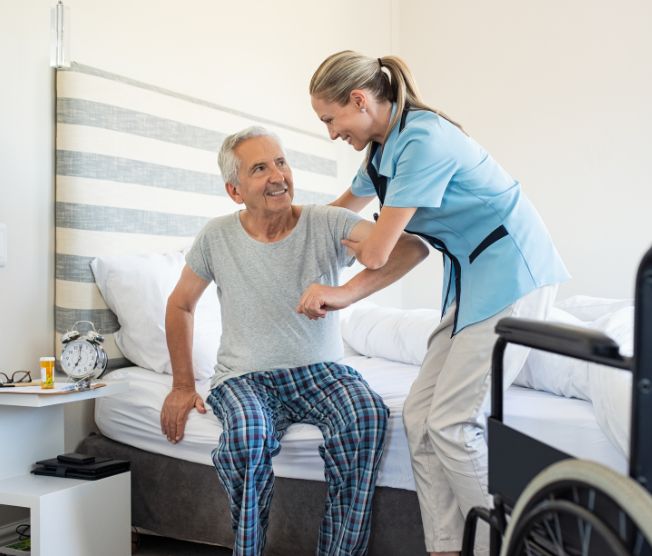 As we grow older, certain evaluations can assess our difficulties performing Activities of Daily Living, also known as ADLs. Related to elderly health, ADLs encompass tasks related to personal care and everyday functioning, including bathing, dressing, cooking, toileting, eating, cleaning and walking.
As we grow older, certain evaluations can assess our difficulties performing Activities of Daily Living, also known as ADLs. Related to elderly health, ADLs encompass tasks related to personal care and everyday functioning, including bathing, dressing, cooking, toileting, eating, cleaning and walking.
Being unable to perform an activity without assistance indicates a limitation. Based on a person’s health, these restrictions may be permanent or temporary. Whether you have noticed changes in your physical abilities or are managing a loved one’s care, here’s what you should know about ADLs.
What Are ADLs?
ADLs provide a baseline to evaluate independent living and determine if assistance or accommodations are needed. Based on the Katz Index of Independence in Activities of Daily Living, these apply to:
- Personal hygiene, including how well you can bathe, groom yourself, brush your teeth and maintain oral health.
- Dressing, including the ability to dress and undress, as well as make decisions about what to wear in relation to the weather and occasion.
- Mobility, including the ability to stand up from a seated position, get out of bed without assistance, walk independently and control your bladder and bowels.
- Eating, including deciding what to eat and being physically able to feed yourself.
- Continence and toileting, including the ability to physically get to a restroom, know when you need to use one and being able to clean yourself up.
What About IADLs?
Instrumental Activities of Daily Living (IADLs) are secondary tasks that you may be evaluated on to determine the level of assistance needed. This group further examines how well you can care for yourself, as well as your home and family, and encompasses more cognitive and organizational skills. Based on the Lawton-Brody scale, IADLs include:
- Communication, such as your ability to use a phone and other technologies.
- Meal preparation, from planning and cooking to storage and cleaning.
- Shopping, particularly decisions regarding food and clothing.
- Transportation, including your driving ability and how you get around.
- Caring for your home, with emphasis on your ability to do basic chores like laundry, washing dishes, vacuuming and yard work.
- Managing your healthcare, particularly regarding medication refills, timing, following doctor’s orders and knowing about dangerous interactions.
- Financial health, from paying your bills and creating a budget to avoiding scams.
Importance of ADLs and IADLs
With age, you may need to access services for elderly or disability care. ADL and IADL assessments determine if you can participate in certain programs, what kind of support you need in your home and if you qualify for nursing home care. More specifically:
- If you intend to use Medicaid for nursing home care, you’ll need to undergo an ADL and IADL assessment.
- Medicare PACE programs and Advantage plans factor in your ability to perform ADLs to provide in-home assistance.
- If you plan to use long-term care insurance, coverage kicks in after you’re unable to perform ADLs.
- You’re more likely to receive Social Security Disability Insurance if you’re unable to perform ADLs.
- Your doctor considers a sudden change in ability to perform ADLs a sign of a medical condition and may be able to provide direction regarding support or treatment.
Establishing if a loved one can perform ADLs and IADLs can also determine how much care they require. Family members and medical professionals can use these benchmarks to assess improvement or deterioration. As a caretaker, you can see:
- If your loved one can live independently or they need to be periodically checked on.
- If your loved one needs physical therapy or an assistive device.
- Which tasks require assistance and if a change in their living situation would be beneficial.
- How much care they require, including more hands-on assistance or hiring certain professionals.
- If your loved one can attend a doctor’s appointment alone or needs you present.
An ADL assessment can determine if certain assistive devices are needed to remain independent at home. Examples include grab bars, shower chairs, bed rails, a raised toilet seat, medication organizer, easy-grip handles on utensils, Velcro shoes or a walker.
Getting an Assessment
A proper assessment will be performed by your doctor or an occupational therapist. Evaluations use one or more of the following methods:
- Katz Index of Independence in Activities of Daily Living, which uses a point system to determine if you can live independently and the type of care you may require.
- Barthel ADL Index, which also uses a point system but asks additional questions for a more comprehensive picture.
- Functional Independence Measure (FIM), which evaluates ADLs, IALDs and other social, cognitive and motor categories using a point system based on task and independence.
Is an ADL Evaluation Needed?
For yourself or a loved one, the following signs can indicate the need for an ADL evaluation:
- A recent car accident or erratic driving behaviors
- Forgetting to pay bills
- Falling victim to a financial scam
- Experiencing a recent fall
- Frequent trips to the emergency room
- Regularly getting lost or wandering
Work with the team at West Hartford Health & Rehabilitation Center to have a loved one evaluated for long-term care. To learn more about our approach, contact us today.
« How Alzheimer’s Disease Can Affect Mobility

